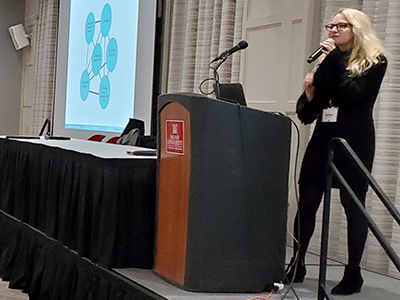"An Intro to Analyzing Network Data" prepares students for exploring information from social media connections

Written by Chi Pham, CAS communications intern
How many friends do you have on your favorite social media platform? Why are you connected to these people? Social networks can be analyzed, and the factors that impact connections can be understood.

Heather Mathews leads the networking workshop.
Miami's Department of Statistics, as part of its 10th year anniversary conference, hosted "An Intro to Analyzing Network Data," a content/career networking workshop, instructed by Miami 2017 alumna Heather Mathews. More than 50 students, alumni, and faculty members from the department and other disciplines sat themselves in the Shriver Center John Dolibois Room to learn about analyzing network data.
This short course introduced how to analyze network data, covering some basic terminology and properties associated with networks. Additionally, a short lab was also included to demonstrate network analysis tools in the R programming language used in statistical computing.
Mathews focuses on social media networks as a doctoral student in statistics at Duke University. Before starting her presentation, with the help of statistics faculty members, Mathews made sure that students were able to download the packages so that they could follow along step-by-step.
"Networks are really everywhere," Mathews said. "Many professions look at networks, from economists and sociologists to biologists. The brain itself is also a network."

Students participating in the workshop
She provided students with some motivating examples to show them what analysis of network data could infer. One example was the "National Longitudinal Study of Adolescent to Adult Health," which investigates what kind of predictive variables might influence the probability of a friendship. From there, researchers could identify possible clustering within networks and figure out whether latent communities exist.
Another example that Mathews presented was the Karate Club study. Two karate instructors had a conflict and divided their club into two opposing factions. The goal of the study was to look at fission in a small community setting and how information flew between the two sides.
Mathews went over statistical concepts and terms of network and relational data. Technical concepts she addressed included sociomatrix, sociability versus popularity, reciprocity, homophily, and the friendship paradox. She also worked with students to examine graphs and relate them back to the adjacent matrix and the stochastic block model, which produces random graphs.
"It's nice to learn about communities and what they look like," Mathews said.
Sijun Chen, who is double majoring in statistics and economics, said this event helped him with his learning. "It's an interesting workshop," he said. "I'm here because I want to get better at drawing connections."
Senior statistics major Maolaaisha Munila added that the workshop was an opportunity for her to improve her skills outside of the classroom. "I'm interested in this kind of topic," she said. "This event was a good resume builder that helps me prepare for my career as a data scientist."

